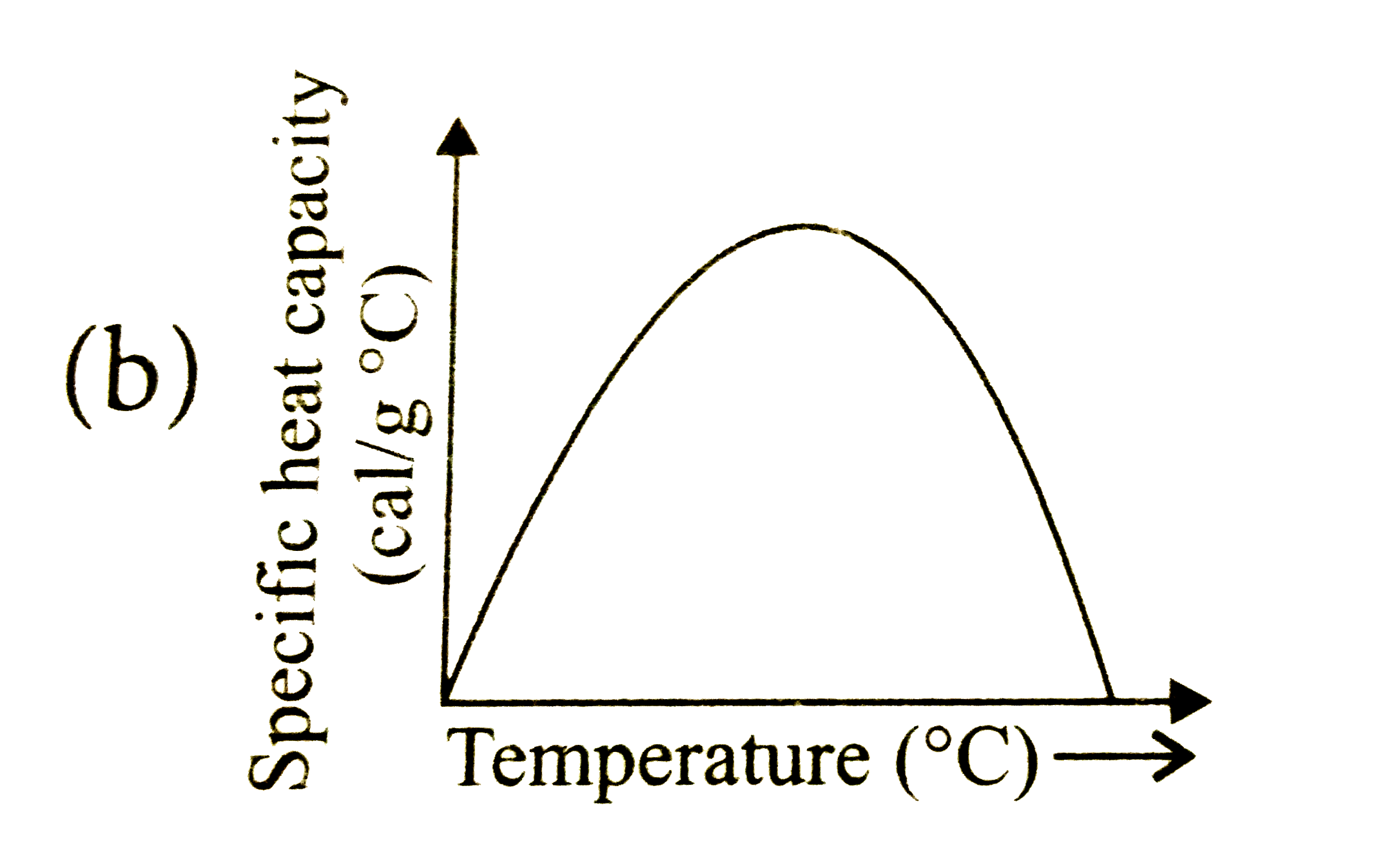Which one of the following graphs represents variation of specific heat capacity of water with temperature?




The correct Answer is:A
To determine which graph represents the variation of specific heat capacity of water with temperature, we can follow these steps:
Step 1: Understand the relationship between specific heat capacity and temperature
The specific heat capacity (C) of a substance is defined as the amount of heat required to raise the temperature of a unit mass of the substance by one degree Celsius. For water, this relationship can vary with temperature.
Step 2: Analyze the behavior of water's density with temperature
- Water has a unique property where its density changes with temperature.
- As the temperature of water increases from 0°C to 4°C, its density increases.
- Beyond 4°C, as the temperature continues to rise, the density of water decreases until it reaches 100°C, where it begins to convert to steam.
Step 3: Relate density changes to specific heat capacity
- Since specific heat capacity is inversely related to density, we can infer the following:
- From 0°C to 4°C: As the density increases, the specific heat capacity decreases.
- From 4°C to 100°C: As the density decreases, the specific heat capacity increases.
Step 4: Identify the correct graph
Given the behavior of specific heat capacity with temperature:
- The specific heat capacity should initially decrease as the temperature increases from 0°C to 4°C.
- After reaching 4°C, the specific heat capacity should start to increase as the temperature continues to rise up to 100°C.
Conclusion
Thus, the graph that represents this behavior is one that shows a decrease in specific heat capacity from 0°C to 4°C, followed by an increase from 4°C to 100°C. This corresponds to Option A.
The specific heat capacity (C) of a substance is defined as the amount of heat required to raise the temperature of a unit mass of the substance by one degree Celsius. For water, this relationship can vary with temperature.
- Water has a unique property where its density changes with temperature.
- As the temperature of water increases from 0°C to 4°C, its density increases.
- Beyond 4°C, as the temperature continues to rise, the density of water decreases until it reaches 100°C, where it begins to convert to steam.
- Since specific heat capacity is inversely related to density, we can infer the following:
- From 0°C to 4°C: As the density increases, the specific heat capacity decreases.
- From 4°C to 100°C: As the density decreases, the specific heat capacity increases.
Given the behavior of specific heat capacity with temperature:
- The specific heat capacity should initially decrease as the temperature increases from 0°C to 4°C.
- After reaching 4°C, the specific heat capacity should start to increase as the temperature continues to rise up to 100°C.
Thus, the graph that represents this behavior is one that shows a decrease in specific heat capacity from 0°C to 4°C, followed by an increase from 4°C to 100°C. This corresponds to Option A.
Topper's Solved these Questions
- THERMODYNAMICSBOOK - NCERT FINGERTPS ENGLISHCHAPTER - THERMODYNAMICSEXERCISE - HOTs
8 Videos
- THERMODYNAMICSBOOK - NCERT FINGERTPS ENGLISHCHAPTER - THERMODYNAMICSEXERCISE - Assertion & Reason
15 Videos
- THERMAL PROPERTIES OF MATTERBOOK - NCERT FINGERTPS ENGLISHCHAPTER - THERMAL PROPERTIES OF MATTEREXERCISE - Assertion And Reason
10 Videos
- UNITS AND MEASUREMENTSBOOK - NCERT FINGERTPS ENGLISHCHAPTER - UNITS AND MEASUREMENTSEXERCISE - Assertion And Reason
15 Videos
Similar Questions
Knowledge Check
The specific heat capacity of water is :
A4200 J kg−1K−1B420 J g−1K−1C0.42 J g−1K−1D4.2 J kg−1K−1
The graph shown the variation with times t of the velocity v of an object . Which one of the following graphs best represents the variation of acceleration a of the object with time t?

View SolutionCan we define specific heat capacity at constant temperature?
View SolutionWhich one of the following graphs represent a one-one function? (FIGURE)
View SolutionWhich of the following graph represents the variation of resistivity (ρ) with temperature (T) for copper?
View SolutionWhich one of the following graphs represents the variation of electric field with distance r from the centre of a charged spherical conductor of radius R?
View SolutionA body moves from rest with a constant acceleration. Which one of the following graphs represents the variation of its kinetic energy K with the distance travelled x?
View SolutionA body moves from rest with a constant acceleration. Which one of the following graphs represents the variation of its kinetic energy K with the distance travelled x?
View Solution
